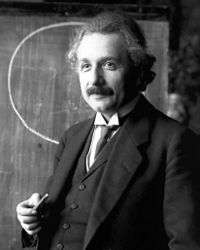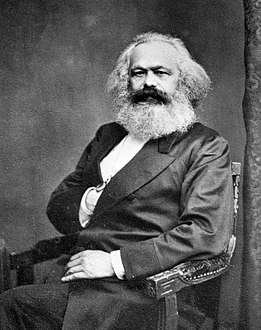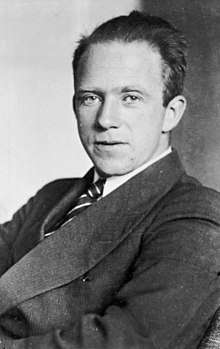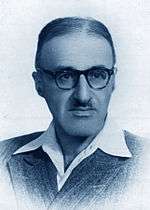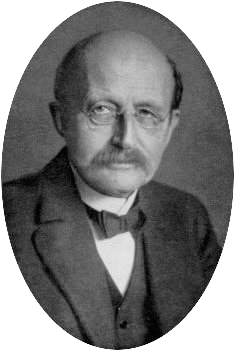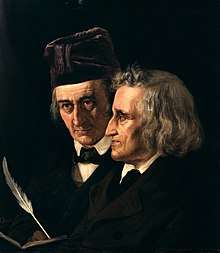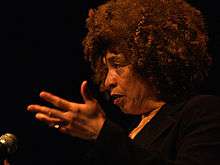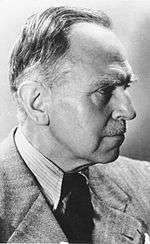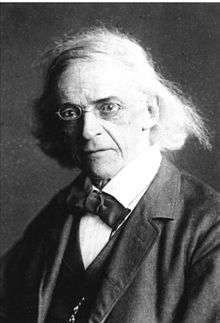Humboldt University of Berlin
Humboldt University of Berlin (German: Humboldt-Universität zu Berlin, abbreviated HU Berlin) is a university in the central borough of Mitte in Berlin, Germany. It was established by Frederick William III on the initiative of Wilhelm von Humboldt, Johann Gottlieb Fichte and Friedrich Ernst Daniel Schleiermacher as the University of Berlin (Universität zu Berlin) in 1809, and opened in 1810,[6] making it the oldest of Berlin's four universities. From 1810 until its closure in 1945, it was named Friedrich Wilhelm University (German: Friedrich-Wilhelms-Universität).[7][8] During the Cold War the university found itself in East Berlin and was de facto split in two when the Free University of Berlin opened in West Berlin. The university received its current name in honour of Alexander and Wilhelm von Humboldt in 1949.[9]
Humboldt-Universität zu Berlin | |
 | |
| Motto | Universitas litterarum (Latin) |
|---|---|
Motto in English | The Entity of Sciences |
| Type | Public |
| Established | 15 October 1810[1] |
| Budget | € 452.9 million (2018)[2] |
| President | Sabine Kunst |
Academic staff | 2,403[3] |
Administrative staff | 1,516[3] |
| Students | 32,553[3] |
| Undergraduates | 18,712[4] |
| Postgraduates | 10,881[4] |
| 2,951[4] | |
| Location | , |
| Campus | Urban and Suburban |
| Nobel Laureates | 55[5] |
| Colors | Blue and White |
| Affiliations | German Universities Excellence Initiative UNICA U15 Atomium Culture EUA IAU FGU Erasmus |
| Website | www.hu-berlin.de |
 | |
The university is divided into nine faculties, including its medical school shared with the Free University of Berlin, has a student enrollment of around 32,000 students, and offers degree programmes in some 189 disciplines from undergraduate to postdoctorate level.[10] Its main campus is located on the Unter den Linden boulevard in central Berlin. The university is known worldwide for pioneering the Humboldtian model of higher education, which has strongly influenced other European and Western universities.[11]
It was regarded as the world's preeminent university for the natural sciences during the 19th and early 20th century, as the university is linked to major breakthroughs in physics and other sciences by its professors, such as Albert Einstein.[12] Former faculty and notable alumni include eminent philosophers, sociologists, artists, lawyers, politicians, mathematicians, scientists, and Heads of State. Among them, the university has an association with 55 Nobel Laureates.[5]
Among its notable alumni, faculty and researchers are Karl Marx, Friedrich Engels, Max Weber, Georg Simmel, Otto von Bismarck, W. E. B. Du Bois, Angela Davis, Walter Benjamin, Karl Liebknecht, Arthur Schopenhauer, Georg Wilhelm Friedrich Hegel, Ernst Cassirer, Heinrich Heine, Albert Einstein, Max Planck.
Humboldt University of Berlin has been conferred the title of "University of Excellence" under the German Universities Excellence Initiative.
History
Main building
The main building of Humboldt University is the Prinz-Heinrich-Palais (English: Prince Henry’s Palace) on Unter den Linden boulevard in the historic centre of Berlin. It was erected from 1748 to 1753 for Prince Henry of Prussia, the brother of Frederick the Great, according to plans by Johann Boumann in Baroque style. In 1809, the former Royal Prussian residence was converted into a university building. Damaged during the Allied bombing in World War II, it was rebuilt from 1949 to 1962.[13]
In 1967, eight statues from the destroyed Potsdam City Palace were placed on the side wings of the university building. Currently there is discussion about returning the statues to the Potsdam City Palace, which was rebuilt as the Landtag of Brandenburg in 2013.[14]
Early history
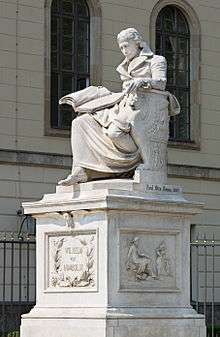
The University of Berlin was established on 16 August 1809, on the initiative of the liberal Prussian educational politician Wilhelm von Humboldt by King Friedrich Wilhelm III, during the period of the Prussian Reform Movement. The university was located in a palace constructed from 1748-1766[15] for the late Prince Henry, the younger brother of Frederick the Great.[16] After his widow and her ninety-member staff moved out, the first unofficial lectures were given in the building in the winter of 1809.[16] Humboldt faced great resistance to his ideas as he set up the university. He submitted his resignation to the King in April 1810, and was not present when the school opened that fall.[1] The first students were admitted on 6 October 1810, and the first semester started on 10 October 1810, with 256 students and 52 lecturers[9] in faculties of law, medicine, theology and philosophy under rector Theodor Schmalz. The university celebrates 15 October 1810 as the date of its opening.[1] From 1828 to 1945, the school was named the Friedrich Wilhelm University, in honor of its founder. Ludwig Feuerbach, then one of the students, made a comment on the university in 1826: "There is no question here of drinking, duelling and pleasant communal outings; in no other university can you find such a passion for work, such an interest for things that are not petty student intrigues, such an inclination for the sciences, such calm and such silence. Compared to this temple of work, the other universities appear like public houses."[17]
The university has been home to many of Germany's greatest thinkers of the past two centuries, among them the subjective idealist philosopher Johann Gottlieb Fichte, the theologian Friedrich Schleiermacher, the absolute idealist philosopher G.W.F. Hegel, the Romantic legal theorist Friedrich Carl von Savigny, the pessimist philosopher Arthur Schopenhauer, the objective idealist philosopher Friedrich Schelling, cultural critic Walter Benjamin, and famous physicists Albert Einstein and Max Planck.
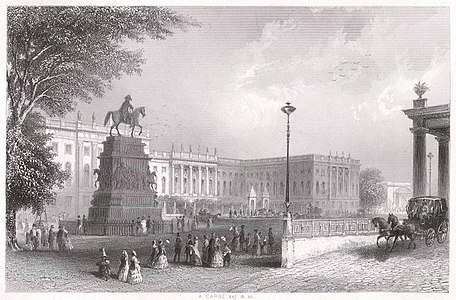
The founders of Marxist theory Karl Marx and Friedrich Engels attended the university, as did poet Heinrich Heine, novelist Alfred Döblin, founder of structuralism Ferdinand de Saussure, German unifier Otto von Bismarck, Communist Party of Germany founder Karl Liebknecht, African American Pan Africanist W. E. B. Du Bois and European unifier Robert Schuman, as well as the influential surgeon Johann Friedrich Dieffenbach in the early half of the 1800s.
The structure of German research-intensive universities served as a model for institutions like Johns Hopkins University. Further, it has been claimed that "the 'Humboldtian' university became a model for the rest of Europe [...] with its central principle being the union of teaching and research in the work of the individual scholar or scientist."[18]
Enlargement
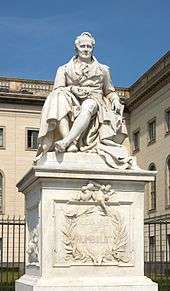
In addition to the strong anchoring of traditional subjects, such as science, law, philosophy, history, theology and medicine, the university developed to encompass numerous new scientific disciplines. Alexander von Humboldt, brother of the founder William, promoted the new learning. With the construction of modern research facilities in the second half of the 19th Century teaching of the natural sciences began. Famous researchers, such as the chemist August Wilhelm Hofmann, the physicist Hermann von Helmholtz, the mathematicians Ernst Eduard Kummer, Leopold Kronecker, Karl Weierstrass, the physicians Johannes Peter Müller, Albrecht von Graefe, Rudolf Virchow and Robert Koch, contributed to Berlin University's scientific fame.
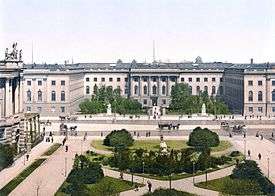
During this period of enlargement, the university gradually expanded to incorporate other previously separate colleges in Berlin. An example would be the Charité, the Pépinière and the Collegium Medico-chirurgicum. In 1710, King Friedrich I had built a quarantine house for Plague at the city gates, which in 1727 was rechristened by the "soldier king" Friedrich Wilhelm: "Es soll das Haus die Charité heißen" (It will be called Charité [French for charity]). By 1829 the site became the Friedrich Wilhelm University's medical campus and remained so until 1927 when the more modern University Hospital was constructed.
The university started a natural history collection in 1810, which, by 1889 required a separate building and became the Museum für Naturkunde. The preexisting Tierarznei School, founded in 1790 and absorbed by the university, in 1934 formed the basis of the Veterinary Medicine Facility (Grundstock der Veterinärmedizinischen Fakultät). Also the Landwirtschaftliche Hochschule Berlin (Agricultural University of Berlin), founded in 1881 was affiliated with the Agricultural Faculties of the University.
Third Reich

After 1933, like all German universities, Friedrich Wilhelm University was affected by the Nazi regime. The rector during this period was Eugen Fischer. It was from the university's library that some 20,000 books by "degenerates" and opponents of the regime were taken to be burned on May 10 of that year in the Opernplatz (now the Bebelplatz) for a demonstration protected by the SA that also featured a speech by Joseph Goebbels. A monument to this can now be found in the center of the square, consisting of a glass panel opening onto an underground white room with empty shelf space for 20,000 volumes and a plaque, bearing an epigraph from an 1820 work by Heinrich Heine: "Das war ein Vorspiel nur, dort wo man Bücher verbrennt, verbrennt man am Ende auch Menschen" ("This was but a prelude; where they burn books, they ultimately burn people").
The Law for the Restoration of the Professional Civil Service (German "Gesetz zur Wiederherstellung des Berufsbeamtentums") resulted in 250 Jewish professors and employees being fired from Friedrich Wilhelm University during 1933/1934 and numerous doctorates being withdrawn. Students and scholars and political opponents of Nazis were ejected from the university and often deported. During this time nearly one third of all of the staff were fired by the Nazis.
Cold War
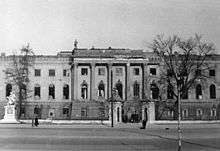
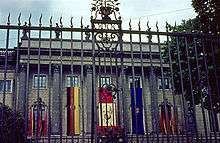
During the Cold War, the university was located in East Berlin. It reopened in 1946 as the University of Berlin, but faced repression from the Soviet Military Administration in Germany, including the persecution of liberal and social democrat students. Almost immediately, the Soviet occupiers started persecuting non-communists and suppressing academic freedom at the university, requiring lectures to be submitted for approval by Socialist Unity Party officials, and piped Soviet propaganda into the cafeteria. This led to strong protests within the student body and faculty. NKVD secret police arrested a number of students in March 1947 as a response. The Soviet Military Tribunal in Berlin-Lichtenberg ruled the students were involved in the formation of a "resistance movement at the University of Berlin", as well as espionage, and were sentenced to 25 years of forced labor. From 1945 to 1948, 18 other students and teachers were arrested or abducted, many gone for weeks, and some taken to the Soviet Union and executed. Many of the students targeted by Soviet persecution were active in the liberal or social democratic resistance against the Soviet-imposed communist "dictatorship"; the German communist party had regarded the social democrats as their main enemies since the early days of the Weimar Republic.[20]During the Berlin Blockade, the Free University of Berlin was established as a de facto western successor in West Berlin in 1948, with support from the United States, and retaining traditions and faculty members of the old Friedrich Wilhelm University. The name of the Free University refers to West Berlin's perceived status as part of the Western "free world," in contrast to the "unfree" Communist world in general and the "unfree" communist-controlled university in East Berlin in particular.[20]
Since the historical name, Friedrich Wilhelm University, had monarchic origins, the school was officially renamed in 1949. Although the Soviet occupational authorities preferred to name the school after a communist leader, university leaders were able to name it Humboldt University of Berlin, after the two Humboldt brothers, a name that was uncontroversial also in the west and capitalized on the fame of the Humboldt name, which is associated with the Humboldtian model of higher education.[21]
Modern Germany

After the German reunification, the university was radically restructured under the Structure and Appointment Commissions, which were presided by West German professors.[22][23] For departments on social sciences and humanities, the faculty was subjected to a "liquidation" process, in which contractions of employees were terminated and positions were made open to new academics, mainly West Germans. Older professors were offered early retirement.[23][24] The East German higher education system included a much larger number of permanent assistant professors, lecturers and other middle level academic positions. After reunification, these positions were abolished or converted to temporary posts for consistency with the West German system.[25] As a result, only 10% of the mid-level academics in Humboldt University still had a position in 1998.[23] Through the transformations, the university's research and exchange links with Eastern European institutions were maintained and stabilized.[22]
Today, Humboldt University is a state university with a large number of students (36,986 in 2014, among them more than 4,662 foreign students) after the model of West German universities, and like its counterpart the Free University of Berlin.
The university consists of three different campuses, namely Campus Mitte, Campus Nord and Campus Adlershof. Its main building is located in the centre of Berlin at the boulevard Unter den Linden and is the heart of Campus Mitte. The building was erected on order by King Frederick II for his younger brother Prince Henry of Prussia. All the institutes of humanities are located around the main building together with the Department of Law and the Department of Business and Economics. Campus Nord is located north of the main building close to Berlin Hauptbahnhof and is the home of the life science departments including the university medical center Charité. The natural sciences, together with computer science and mathematics, are located at Campus Adlershof in the south-east of Berlin. Furthermore, the university continues its tradition of a book sale at the university gates facing Bebelplatz.
Organization
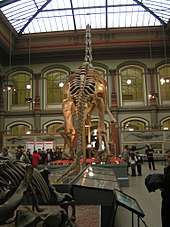
These are the nine faculties into which the university is divided:[26]
- Faculty of Law
- Faculty of Mathematics and Natural Sciences (Geography, Computer Science, Mathematics, Chemistry, Physics)
- Faculty of Life Sciences (Agriculture and Horticulture, Biology, Psychology)
- Charité – Berlin University of Medicine (jointly with Free University of Berlin)
- Faculty of Philosophy I (Philosophy, History, European Ethnology, Department of Library and Information Science)
- Faculty of Philosophy II (Literature, Linguistics, Scandinavian Studies, Romance literatures, English and American Studies, Slavic Studies, Classical Philology)
- Faculty of Humanities and Social Sciences (Social Sciences, Cultural Studies/Arts, Asian/African Studies (includes Archeology), Sport science, Rehabilitation Studies, Education, Quality Management in Education)
- Faculty of Theology
- Faculty of Economics and Business Administration
Furthermore, there are two independent institutes (Zentralinstitute) that are part of the university:
- Centre for British Studies (in German: Großbritannienzentrum)
- Humboldt-Innovation (research transfer and spin-off service)
- Museum für Naturkunde (Natural History Museum)
- Späth-Arboretum
Library
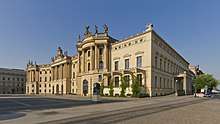
When the Royal Library proved insufficient, a new library was founded in 1831, first located in several temporary sites. In 1871–1874 a library building was constructed, following the design of architect Paul Emanuel Spieker. In 1910 the collection was relocated to the building of the Berlin State Library.
During the Weimar Period the library contained 831,934 volumes (1930) and was thus one of the leading university libraries in Germany at that time.
During the Nazi book burnings in 1933, no volumes from the university library were destroyed. The loss through World War II was comparatively small. In 2003, natural science-related books were outhoused to the newly founded library at the Adlershof campus, which is dedicated solely to the natural sciences.
Since the premises of the State Library had to be cleared in 2005, a new library building was erected close to the main building in the center of Berlin. The "Jacob und Wilhelm Grimm-Zentrum" (Jacob and Wilhelm Grimm Centre, Grimm Zentrum, or GZ as referred to by students) opened in 2009.
In total, the university library contains about 6.5 million volumes and 9,000 held magazines and journals, and is one of the biggest university libraries in Germany.
The books of the Institut für Sexualwissenschaft were destroyed during the Nazi book burnings, and the institute destroyed. Under the terms of the Magnus Hirschfeld Foundation, the government had agreed to continue the work of the institute at the university after its founder's death. However, these terms were ignored. In 2001, the university acquired the Archive for Sexology from the Robert Koch Institute, which was founded with a large private library donated by Erwin J. Haeberle. This has now been housed at the new Magnus Hirschfeld Center.[27]
Academics
| University rankings | |
|---|---|
| Global – Overall | |
| THE World[28] | 67 (2018) |
| USNWR Global[29] | 90 (2019) |
| QS World[30] | 117 (2020) |
Rankings
Measured by the number of top managers in the German economy, Humboldt University ranked 53rd in 2019.[31]
In 2020 the British QS World University Rankings[32] ranked Humboldt University 117th overall in the world and 4th best in Germany. Its subject rankings were: 15th in Arts & Humanities, 13th in Philosophy and 7th in Classics & Ancient History.
The British Times Higher Education World University Ranking 2019 listed Humboldt-University as the 67th best university in the world and 4th best in Germany.[33]
International partnerships
HU students can study abroad for a semester or a year at partner institutions such as the University of Warwick, Princeton University, and the University of Vienna.
Notable alumni and faculty
.jpg)
As of October 2019, the university has been associated with 55 Nobel Prize winners (including former students, faculty and researchers).
- Theodore Dyke Acland (1851–1931), surgeon and physician
- Bozorg Alavi (1904–1997), novelist and writer
- Alexander Altmann (1906–1987), rabbi and scholar of Jewish philosophy and mysticism
- Gerhard Anschütz (1867–1948), leading jurisprudent and "father of the constitution" of the state of Hesse
- Jörg Baberowski (born 1961), professor of eastern European history
- Michelle Bachelet (born 1951), pediatrician and epidemiologist, president of the Republic of Chile
- Azmi Bishara (born 1956), Arab-Israeli politician
- Bruno Bauer (1809–1882), theologian, Bible critic and philosopher
- Jurek Becker (1937–1997), writer (Jacob the Liar)
- Eliezer Berkovits (1908–1992), rabbi, philosopher and theologian
- Algernon Sydney Biddle (1847-1891), American lawyer and law professor at the University of Pennsylvania Law School
- Otto von Bismarck (1815–1898), first German chancellor
- Dietrich Bonhoeffer (1906–1945), theologian and resistance fighter
- Beatrix Borchard, (born 1950), musicologist
- Max Born (1882–1970), physicist, Nobel Prize for physics in 1954
- Aron Brand (1910–1977), pediatric cardiologist
- Rudolf Brandt (1909–1948), Nazi SS officer, executed for war crimes
- Gottlieb Burckhardt (1836–1907), psychiatrist, first physician to perform modern psychosurgery (1888)
- Michael C. Burda, macroeconomist
- Stepan Shahumyan (1878–1918), Armenian communist politician and head of the Baku Commune
- Ezriel Carlebach (1909–1956), Israeli journalist and editorial writer
- Ernst Cassirer (1874–1945), philosopher
- Adelbert von Chamisso (1781–1838), natural scientist and writer
- Georg von Dadelsen (1918–2007), musicologist, Neue Bach-Ausgabe
- Angela Davis (born 1944), political activist, educator, author, philosopher
- Gustav Adolf Deissmann (1866-1937), theologian, New Testament Greek philologist, author, Nobel nominee
- Suat Derviş (1904/1905–1972), Turkish novelist, journalist, and political activist
- Harilal Dhruv (1856–1896), Indian lawyer, poet, indologist
- Wilhelm Dilthey (1833–1911), philosopher
- Georg Dohrn, conductor
- W. E. B. Du Bois (1868–1963), African-American activist and scholar
- Paul Ehrlich (1854–1915), physician, Nobel Prize for medicine in 1908
- Albert Einstein (1879–1955), physicist, Nobel Prize for physics in 1921
- Gotthold Eisenstein (1823–1852), mathematician, specialized in number theory and analysis
- Friedrich Engels (1820–1895), journalist and philosopher
- Annemarie Esche, scholar of Burmese literature
- Ludwig Andreas Feuerbach (1804–1872), philosopher
- Johann Gottlieb Fichte (1762–1814), philosopher, rector of the university (1810–1812)
- Horst Fischer (1912–1966), SS concentration camp doctor executed for war crimes
- Emil Fischer (1852–1919), founder of modern biochemistry, Nobel Prize in chemistry in 1902
- Werner Forßmann (1904–1979), physician, Nobel Prize for medicine in 1956
- James Franck (1882–1964), physicist, Nobel Prize for physics in 1925
- Wilhelm Frick (1877-1946), Nazi official, executed for war crimes
- Karl Gebhardt (1897–1948), Nazi SS physician who conducted criminal medical experiments; executed for war crimes
- Ernst Gehrcke (1878–1960), experimental physicist
- Jacob Grimm (1785–1863), linguist and literary critic
- Wilhelm Grimm (1786–1859), linguist and literary critic
- Gregor Gysi (1948–), German politician and lawyer
- Fritz Haber (1868–1934), chemist, Nobel Prize for chemistry in 1918
- Otto Hahn (1879–1968), chemist, Nobel Prize for chemistry in 1944
- Sir William Reginald Halliday (1886–1966), principal of King's College London (1928–1952)
- Robert Havemann (1910–1982), chemist, co-founder of European Union, and leading GDR dissident
- Georg Wilhelm Friedrich Hegel (1770–1831), philosopher, rector of the university (1830–1831)
- Heinrich Heine (1797–1856), writer and poet
- Werner Heisenberg (1901–1976), physicist, Nobel Prize for physics in 1932
- Hermann von Helmholtz (1821–1894), physician and physicist
- Gustav Hertz (1887–1975), physicist, Nobel Prize for physics in 1925
- Paula Hertwig (1889–1983), biologist, politician
- Heinrich Hertz (1857–1894), physicist
- Abraham Joshua Heschel (1907–1972) rabbi, philosopher, and theologian
- Jacobus Henricus van 't Hoff (1852–1911), chemist, Nobel Prize for chemistry in 1901
- Johanna Hellman (1889 - 1982), surgeon
- Max Huber (1874–1960), international lawyer and diplomat
- Christoph Wilhelm Hufeland (1762–1836), founder of macrobiotics
- Wilhelm von Humboldt (1767–1835), politician, linguist, and founder of the university
- Alexander von Humboldt (1769–1859), natural scientist
- Zakir Hussain (1897–1969), third president of India
- Yitzchok Hutner American Orthodox rabbi and rosh yeshiva (dean)
- Sadi Irmak (1904–1990), Prime minister of Turkey
- Elisabeth Jastrow (1890–1981), German-born American classical archaeologist
- Hermann Kasack (1896–1966), writer
- George F. Kennan (1904–2005), American diplomat, political scientist and historian
- Gustav Kirchhoff (1824–1887), physicist
- Paul Alfred Kleinert, German writer, editor and translator
- Robert Koch (1843–1910), physician, Nobel Prize for medicine in 1905
- Komitas Vardapet (1869–1935) Armenian priest, composer, ethnomusicologist, music pedagogue, singer, choirmaster and the founder of the Armenian classical music.
- Albrecht Kossel (1853–1927), physician, Nobel Prize for medicine in 1910
- Arnold Kutzinski (died 1956), psychiatrist
- Edmund Landau (1877–1938), mathematician
- Arnold von Lasaulx (1839–1886) mineralogist and petrographer
- Max von Laue (1879–1960), physicist, Nobel Prize for physics in 1914
- Yeshayahu Leibowitz (1903–1994), Israeli public intellectual and polymath
- Nechama Leibowitz Israeli Bible scholar
- Wassily Leontief (1905–1999), economist, Nobel Prize for economics in 1973
- Karl Liebknecht (1871–1919), socialist politician and revolutionary
- Friedrich Loeffler (1852–1915), bacteriologist
- Ram Manohar Lohia (1910–1967), Indian activist and politician
- Karl Adolf Lorenz (1837–1923), composer
- Judah Leon Magnes, rabbi, Chancellor/President of the Hebrew University of Jerusalem, 1925-1948
- Herbert Marcuse (1898–1979), philosopher
- Karl Marx (1818–1883), philosopher and sociologist
- Ernst Mayr (1904–2005), biologist
- Benjamin Mazar (1906–1995), President of Hebrew University of Jerusalem
- Joachim Mrugowsky (1905–1948), Nazi doctor executed for war crimes
- Lise Meitner (1878–1968), physicist, Enrico Fermi Award in 1966
- Felix Mendelssohn (1809–1847), composer
- Theodor Mommsen (1817–1903), historian, Nobel Prize for literature in 1902
- Edmund Montgomery (1835–1911), philosopher, scientist, physician
- John von Neumann (1903–1957), mathematician and physicist
- Max Planck (1858–1947), physicist, Nobel Prize for physics in 1918
- Gordon Prange (1910–1980), American historian
- Leopold von Ranke (1795–1886), historian
- Otto Friedrich Ranke (1899–1959), physiologist
- Erich Regener (1881–1955), physicist
- Robert Remak (1815–1865), cell biologist
- Friedrich Wilhelm Joseph Schelling (1775–1854), philosopher
- Friedrich Daniel Ernst Schleiermacher (1768–1834), philosopher
- Moritz Schlick (1882-1936), philosopher
- Bernhard Schlink (born 1944), writer, Der Vorleser (The Reader)
- Carl Schmitt (1888–1985), German jurist, political theorist, and professor of law
- Menachem Mendel Schneerson (1902–1994), rabbi, philosopher, theologian, engineer, educator and writer
- Edith Schönert-Geiß (1933-2012), numismatist
- Arthur Schopenhauer (1788–1860), philosopher
- Erwin Schrödinger (1887–1961), physicist, Nobel Prize for physics in 1933
- Peter Schubert (1938–2003), diplomat and albanologist
- Georg Simmel (1858–1918), philosopher and sociologist
- Joseph B. Soloveitchik (1903–1993), rabbi, philosopher, and theologian
- Herman Smith-Johannsen (1875–1987), sportsman who introduced cross-country skiing to North America
- Werner Sombart (1863–1941), philosopher, sociologist and economist
- Hans Spemann (1869–1941), biologist, Nobel Prize for biology in 1935
- Hermann Stieve (1886–1952), anatomist who did research on bodies of Nazi execution victims
- Max Stirner (1806–1856), philosopher
- Yemima Tchernovitz-Avidar (1909–98), Israeli author
- Gustav Tornier (1859–1938), paleontologist and zoologist
- Kurt Tucholsky (1890–1935), writer and journalist
- Rudolf Virchow (1821–1902), physician and politician
- Luis Villar Borda (1929–2008), Colombian politician and diplomat
- Alfred Wegener (1880–1930), scientist, geologist, and meteorologist, early theorist of continental drift
- Karl Weierstraß (1815–1897), mathematician
- Max Westenhöfer (1871–1957), pathologist, proposed the Aquatic ape hypothesis, reformer of field of pathology in Chile
- Wilhelm Heinrich Westphal (1882–1978), physicist
- Wilhelm Wien (1864–1928), physicist, Nobel Prize for physics in 1911
- Ulrich von Wilamowitz-Moellendorff (1848–1931), philologist
- Richard Willstätter (1872–1942), chemist, Nobel Prize for chemistry in 1915
- Annette Schmiedchen (born 1966), Indologist and Padma Shri award winner
- Max Weber (1864–1920), sociologist, philosopher, and political economist
- Rabbi Shlomo Wolbe Orthodox Rabbi and author of the Alei Shur
- Ivan Lysiak-Rudnytsky (1919–1984), Ukrainian-Canadian historian, political scientist, publicist
Nobel Prize laureates
There are 55 Nobel Prize winners affiliated with the Humboldt University:
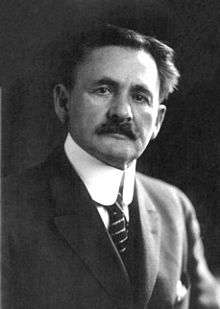
- 1901 Jacobus Henricus van 't Hoff (Chemistry)
- 1901 Emil Adolf von Behring (Physiology or Medicine)
- 1902 Hermann Emil Fischer (Chemistry)
- 1902 Theodor Mommsen (Literature)
- 1905 Adolf von Baeyer (Chemistry)
- 1905 Robert Koch (Physiology or Medicine)
- 1907 Albert Abraham Michelson (Physics)
- 1907 Eduard Buchner (Chemistry)
- 1908 Paul Ehrlich (Physiology or Medicine)
- 1909 Karl Ferdinand Braun (Physics)
- 1910 Otto Wallach (Chemistry)
- 1910 Albrecht Kossel (Physiology or Medicine)
- 1910 Paul Heyse (Literature)
- 1911 Wilhelm Wien (Physics)
- 1914 Max von Laue (Physics)
- 1915 Richard Willstätter (Chemistry)
- 1918 Fritz Haber (Chemistry)
- 1918 Max Planck (Physics)
- 1920 Walther Nernst (Chemistry)
- 1921 Albert Einstein (Physics)
- 1925 Gustav Ludwig Hertz (Physics)
- 1925 James Franck (Physics)
- 1925 Richard Adolf Zsigmondy (Chemistry)
- 1928 Adolf Otto Reinhold Windaus (Chemistry)
- 1929 Hans von Euler-Chelpin (Chemistry)
- 1931 Otto Heinrich Warburg (Physiology or Medicine)
- 1932 Werner Heisenberg (Physics)
- 1933 Erwin Schrödinger (Physics)
- 1935 Hans Spemann (Physiology or Medicine)
- 1936 Peter Debye (Chemistry)
- 1939 Adolf Butenandt (Chemistry)
- 1944 Otto Hahn (Chemistry)
- 1945 Ernst Boris Chain (Physiology or Medicine)
- 1950 Kurt Alder (Chemistry)
- 1950 Otto Diels (Chemistry)
- 1953 Fritz Albert Lipmann (Physiology or Medicine)
- 1953 Hans Adolf Krebs (Physiology or Medicine)
- 1954 Max Born (Physics)
- 1956 Walther Bothe (Physics)
- 1991 Bert Sakmann (Physiology or Medicine)
- 2007 Gerhard Ertl (Chemistry)
See also
References
- Langner, Stefanie. "Man beruft eben tüchtige Männer und läßt die Universität sich allmählich encadrieren — Humboldt-Universität zu Berlin". www.hu-berlin.de.
- "Leistungsbericht über das Jahr 2018 zur Umsetzung des Hochschulvertrags 2018 - 2022" (PDF) (in German). Senate Chancellery of Berlin. p. 25. Retrieved 2020-08-03.
- "Facts and Figures". Humboldt University of Berlin. Retrieved 2017-06-15.
- "Archived copy". Archived from the original on 2013-12-03. Retrieved 2013-12-02.CS1 maint: archived copy as title (link)
- Wikipedia. "List of Nobel laureates by university affiliation — Humboldt-Universität zu Berlin". Retrieved 2020-06-27.
- "Das moderne Original der Reformuniversität" (in German). Humboldt-Universität zu Berlin. Retrieved 15 January 2018.
- "Humboldt University of Berlin - university, Berlin, Germany". Encyclopedia Britannica.
- During that period, it was also unofficially called Universität unter den Linden after its location in the former palace of Prince Henry of Prussia which his brother, King Frederick II, had built for him between 1748 and 1753 on the avenue Unter den Linden.
- "Berlin's oldest university faces new challenges as it turns 200 - DW - 15.10.2010". DW.COM.
- hu_adm. "Daten und Zahlen zur Humboldt-Universität — Humboldt-Universität zu Berlin". www.hu-berlin.de (in German). Retrieved 2018-01-11.
- Connell Helen, University Research Management Meeting the Institutional Challenge: Meeting the Institutional Challenge, p. 137, OECD, 2005, ISBN 9789264017450
- Hans C. Ohanian, Einstein's Mistakes: The Human Failings of Genius, p. 156, W. W. Norton & Company, 2009, ISBN 9780393070422
- Humboldt-Universität (in German) Landesdenkmalamt Berlin
- Die Attikaskulpturen (in German) Humboldt-Universität zu Berlin
- temp_adm. "Short History — Humboldt-Universität zu Berlin". www.hu-berlin.de.
- Nolte, Dorothee (12 October 2009). "200 Jahre Humboldt-Uni: Der Ort: Ein Palais Unter den Linden" – via Die Zeit.
- Mclellan, David (1981). Karl Marx: A Biography (Fourth ed.). Palgrave Macmillan. p. 15.
- Anderson, Robert (March 2010). "The 'Idea of a University' today". History & Policy. United Kingdom: History & Policy. Retrieved 2010-12-09.
- Rüegg 2004, pp. 4–6
- Schrader, Helena P. The blockade breakers : the Berlin Airlift. ISBN 978-0-7524-6803-7. OCLC 893685205.
- "Die Umbenennung zur "Humboldt-Universität" — Presseportal". Hu-berlin.de (in German). Retrieved 2016-08-28.
- "Short History". Humboldt-Universität zu Berlin. Retrieved 2 June 2020.
- Boesch, Frank (2018). A History Shared and Divided: East and West Germany since the 1970s. Berghahn Books. p. 419. ISBN 9781785339264. Retrieved 2 June 2020.
- Fair-Schulz, Axel; Kessler, Mario (2017). East German Historians since Reunification: A Discipline Transformed. SUNY Press. p. 119. ISBN 9781438465388.
- Polyzoi, Eleoussa; Fullan, Michael; Anchan, John P. (2003). Change forces in post-communist Eastern Europe. Routledge. p. 103. ISBN 9780415306591.
- "Faculties and Departments". Humboldt-Universität zu Berlin. Retrieved 2015-08-22.
- Erwin J Haeberle". "Berlin and its Sexological Heritage". Magnus Hirschfeld Archive for Sexology. Archived from the original on 2009-08-30.
- "World University Rankings 2018 - Humboldt University of Berlin". Times Higher Education (THE). Retrieved 2018-08-21.
- "Best Global Universities 2019". U.S. News Education (USNWR). Retrieved 2019-07-26.
- "QS World University Rankings 2020". Top Universities. Retrieved 2020-06-25.
- "An diesen Unis haben die DAX-Vorstände studiert | charly.education". www.charly.education (in German). Retrieved 2019-10-19.
- "Humboldt-Universität zu Berlin". Topuniversities.com. Retrieved 2020-06-25.
- "Humboldt University of Berlin". Timeshighereducation.com. Retrieved 2018-10-03.

